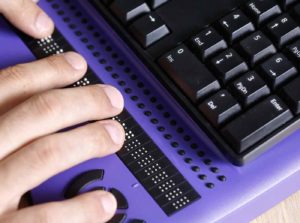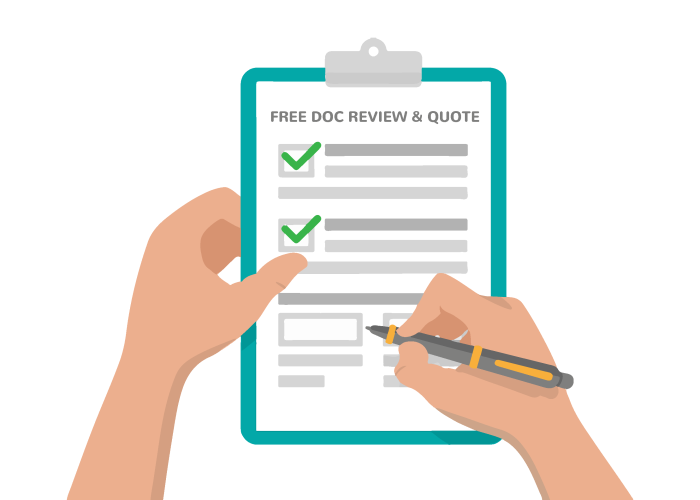Understanding digital accessibility challenges is easy if you know people with disabilities. But what if you’ve never seen a person who is blind use their computer or smartphone? This article is here to help you understand a little bit about what it’s like to use the internet if you have a disability.
What do we mean by “deaf-blind?”
A person is considered deaf-blind if they have some combination of hearing loss and vision loss. While there are some people who are totally deaf and totally blind, the majority of deaf-blind people have some amount of residual hearing and/or vision. Some will have more vision than hearing; others will have more hearing than vision.
It is important to note that if you see someone using a white cane or a guide dog, that does not mean they are totally blind. It means they have sufficient vision loss that having a dog or cane makes it easier and safer for them to navigate independently.
Assistive Technology Used by Deaf-Blind People
Assistive technology (AT) is a broad term that refers to hardware and software that enable people with disabilities to access technology. Those who are deaf-blind use a combination of AT for blind users and AT for deaf users, depending on their individual needs.
AT for Visual Disabilities
- Screen Readers: A program that analyzes the layout and content of a website or electronic document and provides a text to speech translation. The playback speed can be set by the user and commands allow them to skip from heading to heading, click links, and do other important tasks.
- Braille Displays: A device that translates digital text into braille dots that can be read with the fingers. (More on braille below, as it is very important to many deaf-blind people.)
- Dictation: Speech recognition software allows a user to navigate, type, and interact with websites and electronic documents using their voice.
AT for Hearing Disabilities
- Alerting Devices: A device that converts an audio alert (e.g., doorbell, alarm clock) into a visual or physical alert that the person can perceive.
- Telecommunications: Many different options are available for those who are D/deaf or HoH, including amplified telephones, TTY / TDD, Text-to-911, and video chat.
- Enhanced Listening: Systems can be used to connect an audio feed directly to someone’s hearing aid or cochlear implant.
- Visual communication: Captions and transcripts (with the ability to enlarge or zoom in!) provide audio information in a visual format.
The Importance of Braille for Deaf-Blind Users
For some deaf-blind people, braille is the only way they can read. For others, braille is the fastest way to read.
Documents and Transcripts
If electronic documents and transcripts are formatted with accessibility in mind, they can be translated by braille devices for a person who is deaf-blind.

Phone Communication
Each state has a program for people who are deaf or deaf-blind to make and receive phone calls.
A person who is deaf-blind can make phone calls using TTY (text telephone)-to-braille with the help of a communication assistant (CA). The CA serves as the interpreter between the two parties and types out the messages so the deaf-blind person can read them using their braille device. Some of these services are also available in Spanish.
Remote Conference Captioning is also available for deaf-blind users who participate in conference calls for work.
Free equipment for deaf-blind people
The federal program iCanConnect offers free technology and training for those who are deaf-blind. iCanConnect is the easier-to-remember name of the National Deaf-Blind Equipment Distribution Program (NDBEDP—say that three times fast!), which was established by the FCC as part of the CVAA.
The mission of this program is to give deaf-blind people access to the technology they need to stay connected with the world. This includes braille devices, computers, tablets, smartphones, vibrating alert devices, accessories, and software.
Accessibility Barriers for Deaf-Blind Users
Here are some accessibility issues that restrict access to people who are deaf-blind. Since each deaf-blind person is a different amount of deaf and blind, accessibility issues can come from both sides!
Accessibility issues for visual disabilities
- No Keyboard Navigation: Can you use your website, program, or electronic document without a mouse? Use the tab key, arrows, and enter to navigate.
- Pop-Pops: If websites or electronic documents fail to set reading focus appropriately, a pop-up dialog can prevent a blind user from moving forward… or even knowing how to get back to where they were.
- Cluttered Pages: Cluttered pages and text aren’t user friendly for blind users. (Spoiler alert: They aren’t user friendly for many people.)
- ARIA Mistakes: If websites misuse ARIA markup, it changes a screen reader’s behavior in a way that interferes with navigation and operability.
- Document Heading and Labeling: Without proper heading tags, a screen reader user cannot quickly locate what they want to read.
- Alt Text: Images that convey meaning need to be tagged with alt text so the person who is reading your website or electronic document can hear a description of the image.
Accessibility Issues for Hearing Disabilities
- Inaccurate Captions: Automated captions are a blessing and a curse. It can be great to have captions, but AI is far from perfect and sometimes automated captions are worse than no captions at all.
- No Transcripts: For a deaf-blind person who uses braille, transcripts are a must-have in order to access information presented in video or audio format.
- Phone-Only Customer Support: Nothing is more frustrating than trying to contact a business and finding out the only option to do so is a phone number.
- Low-Quality Audio: Poor quality audio becomes even worse at high volume. It can also be difficult to transcribe accurately.
The Bottom Line: Design to Include Deaf-Blind People
You can make your websites and electronic documents with people with disabilities in mind and you can retrofit. It’s a win-win situation for your business or organization (more clients, more revenue, more contracts) and people with disabilities (less confusion, less frustration, less isolation). Some fixes, like ensuring your PDF documents pass accessibility checkers, are quick to implement and make a big impact on the user experience.





